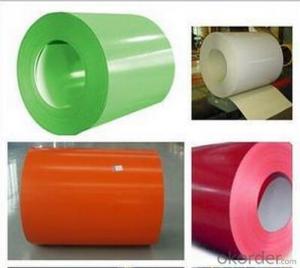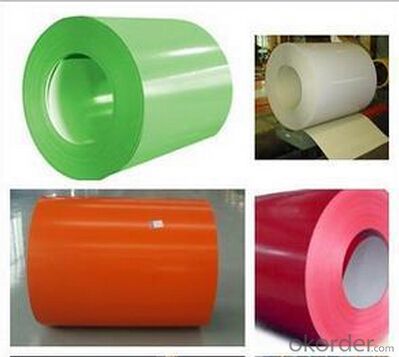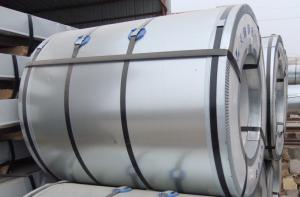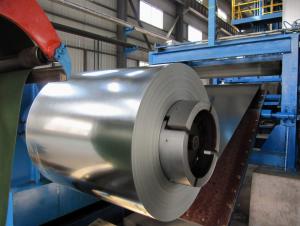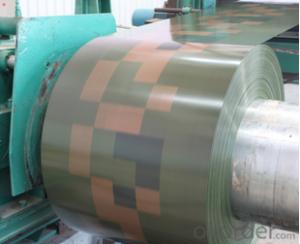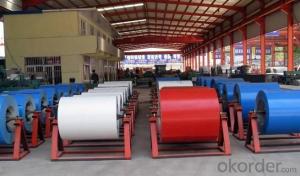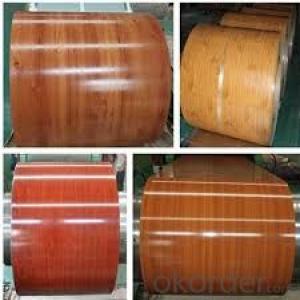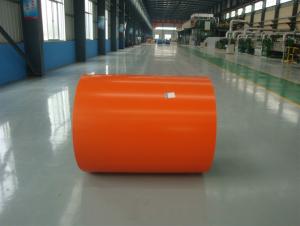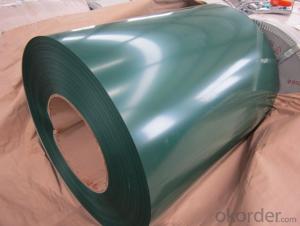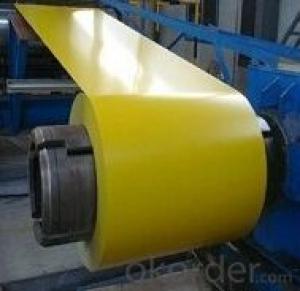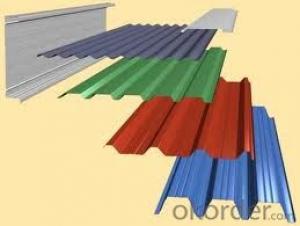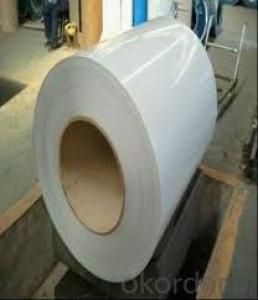Pre-painted Galvanized Steel Coil/Color Coated Steel Coils
- Loading Port:
- Tianjin
- Payment Terms:
- TT OR LC
- Min Order Qty:
- 10 m.t.
- Supply Capability:
- 1000 m.t./month
OKorder Service Pledge
OKorder Financial Service
You Might Also Like
Specification
1.Introduction of Prepainted Galvanized Steel Coil:
Galvanized steel coil is a special type of steel coil used in a number of different applications within fabrication and manufacturing environments. Steel coil of any kind is flat stock that is thin enough to be rolled into a coil or wound into a continuous roll.
2.Usages of Prepainted Galvanized Steel Coil:
With excellent cold bending molded manufacturability, good decoration effect, strong anti-corrosion ability, galvanized steel coils and sheets are also pollution-free and easily recycled. Accordingly, they can be used as final products and basic plates of color coated steel coils and widely applied in construction, home appliances, decoration, ect.
3.Prepainted Galvanized Steel Images:
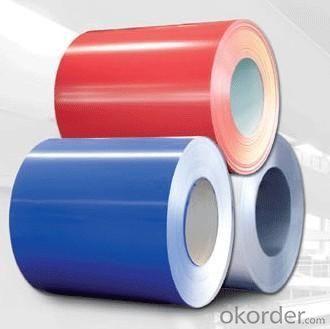
4.Galvanized Steel Specification:
Product | PPGI/PPGL | Galvanized | Galvalume/Aluzinc |
Certificate | ISO9001:2008,ISO14001:2004 | ||
standard | ASTM A755 | ASTM A653 | ASTM A792 |
Grade | CGCC/CGLCC | SGCC/CS/DX51D | SGLCC/CS/DX51D |
Model | Thick:0.16-0.90mm | Thick:0.14-3.5mm | Thick:0.23-2.0mm |
Type | Roll/Coil | Roll/Coil | Roll/Coil |
surface | Protective | Chromating Treatment Oiled | |
Application | Structural,Roofing,Commercial use,Household Appliance,Industry | ||
Special | Wear resistant steel,High-strength-steel plate | ||
5.Our Factory:

6.FAQ
We have organized several common questions for our clients,may help you sincerely:
①How about your Warranty?
Warranty: 1-Year for the whole light. Warranty is based on correct storage, installation, using and maintenanc
②How to guarantee the quality of the products?
We have established the international advanced quality management system,every link from raw material to final product we have strict quality test;We resolutely put an end to unqualified products flowing into the market. At the same time, we will provide necessary follow-up service assurance.
③How long can we receive the product after purchase?
In the purchase of product within three working days, We will arrange the factory delivery as soon as possible. The pecific time of receiving is related to the state and position of customers.Commonly 7 to 10 working days can be served.
- Q: How are steel coils used in the production of aerospace components?
- Steel coils find multiple applications in the production of aerospace components. One primary use involves their use in the manufacturing of structural parts like frames, beams, and brackets. To achieve this, steel coils are often transformed into flat sheets or strips, which are subsequently cut and shaped into the desired form for these components. Given the strong and durable nature of steel, it is an ideal material for these critical parts that must withstand extreme forces and conditions. Moreover, steel coils are also indispensable in the production of engine components, including turbine blades and combustion chambers. These components demand materials with exceptional mechanical properties and high resistance to elevated temperatures. Consequently, steel coils undergo processing and shaping to create intricate forms, ensuring the efficient and reliable functioning of these vital engine parts. Furthermore, steel coils play a crucial role in the production of fasteners, such as bolts, nuts, and screws, which are essential for assembling various aerospace components. The exceptional strength and corrosion resistance of steel make it the preferred choice for these fasteners, as they must endure the intense forces and harsh environments encountered during flight. In summary, the utilization of steel coils is of utmost importance in the production of aerospace components, as they provide the necessary strength, durability, and reliability required for safe and efficient operation in the demanding aerospace industry.
- Q: How long can steel coils be stored before they need to be used?
- Steel coils can typically be stored for an extended period of time, ranging from a few months to several years, depending on various factors such as the coating, storage conditions, and the type of steel. However, it is generally recommended to use or sell steel coils within a year or two to ensure their optimal quality and performance.
- Q: What is the maximum width of steel coils?
- The maximum width of steel coils is subject to variation, influenced by factors like steel type, manufacturing capabilities, and intended usage. Nevertheless, in most cases, steel coils tend to have a maximum width of approximately 2,200 millimeters or 86.6 inches. This width is widely employed in the steel industry for coils of standard sizes. It is worth mentioning that wider widths may be achievable through specialized steel coils or custom manufacturing methods, albeit less frequently and possibly necessitating particular equipment or processes.
- Q: How are steel coils used in the production of steel tanks?
- Steel coils are used in the production of steel tanks by being cut and shaped into the desired size and shape of the tank. These coils are typically made of high-quality steel, which provides strength and durability to the tanks. The coils are processed through various manufacturing techniques like rolling, bending, and welding to create the tank's body, ensuring a seamless structure. Additionally, the coils can also be used to create the tank's base, lid, and other components, resulting in a complete and sturdy steel tank suitable for various applications.
- Q: How are steel coils used in the production of HVAC ducts?
- Steel coils are used in the production of HVAC ducts as they are rolled into a specific shape and size to form the main body of the duct. The coils are then cut and welded together to create a seamless and durable structure that can withstand the high temperatures and pressures associated with HVAC systems.
- Q: What are the dimensions of steel coils used in automotive component manufacturing?
- The dimensions of steel coils used in automotive component manufacturing can vary depending on the specific requirements of each component. However, standard dimensions for steel coils used in this industry typically range from 0.5 to 3 millimeters in thickness and 600 to 2,000 millimeters in width. The weight of these coils can also vary, but they typically range from 2 to 25 metric tons. These dimensions are chosen to ensure that the coils can be easily processed and transformed into the necessary automotive components, while also meeting the required strength and durability standards for use in vehicles.
- Q: Can steel coils be perforated?
- Yes, steel coils can be perforated. Perforation is the process of creating small holes or punctures in a material, and steel coils can undergo this process to achieve specific purposes such as enhancing ventilation, improving drainage, or creating decorative patterns.
- Q: What are the different surface treatments available for steel coils?
- There are various surface treatments available for steel coils, including galvanizing, painting, powder coating, and zinc coating. These treatments help protect the steel from corrosion and improve its durability and appearance.
- Q: Can steel coils be coated with abrasion-resistant materials?
- Yes, steel coils can be coated with abrasion-resistant materials. These materials are applied to the surface of the steel coils to enhance their resistance to wear and tear caused by friction, impact, or scratching. The abrasion-resistant coating provides a protective layer that helps prolong the lifespan and durability of the steel coils.
- Q: What are the different steel coil packaging methods?
- There are several different steel coil packaging methods, including using steel strapping, wrapping with plastic or stretch film, placing the coils in wooden crates, or using steel coil sleeves or eye-to-sky packaging.
Send your message to us
Pre-painted Galvanized Steel Coil/Color Coated Steel Coils
- Loading Port:
- Tianjin
- Payment Terms:
- TT OR LC
- Min Order Qty:
- 10 m.t.
- Supply Capability:
- 1000 m.t./month
OKorder Service Pledge
OKorder Financial Service
Similar products
Hot products
Hot Searches
Related keywords
